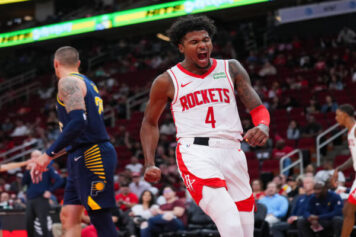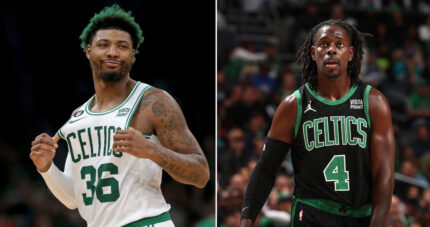John Starks didn’t quit on the Knicks during Game 7 of the ’94 NBA Finals loss to the Houston Rockets.
He never gave up or stopped shooting. Packing it in wasn’t his steez.
Every air ball and rim-clanging shot was like Chinese water torture to Knicks fans, whom, based on Starks' streaky shooting, assumed the next shot was the one that would get him going and lift the Knicks to their first World Championship since 1972.
Starks hoisted up 18 shots that night. The ball might as well have been a virgin and the basket a porn star because they didn’t connect – at all. Knicks coach Pat Riley defiantly stuck by his gunner and, when the smoke cleared, Starks shot 11 percent from the field, including a dismal 0-11 from behind the arc. He’s remembered as the main culprit in the most forgettable and demoralizing evening in recent Knicks history.
That was just one game. But it will forever define Starks’ Knicks career.
The expression, “if you live long enough, you’ll see history repeat itself” holds true in the enigmatic case of J.R. Smith — the new John Starks.
Might as well call them R. Kelly and Hova, because they represent the Best of Both Worlds when it comes to breaking opponents backs one minute and breaking Knicks fans’ hearts the next.
They also both have impeccable timing with their slumps.
After ending the season hot as lava, Smith is now mired in a 26-for-91 (28.6%) shooting slump over his last six playoff games, including 10-for-37 (27%) from three-point range. Unfortunately for the Knicks, whose anemic offense has left them in a 3-1 hole against Indiana, Smith couldn’t have picked a worse time to starting spazzing.
The Knicks had high hopes of at least advancing to the Eastern Conference Finals against the Heat, after winning their first Atlantic Division championship since those bittersweet Starks years.
For Starks, it was just one memorably tough night, but his failures in the magnitude of the moment overshadow the magic he had in NY. Remember “The Dunk,” in the 1993 Eastern Conference Finals, when he posterized the great MJ and Horace Grant? The Knicks came up short, but Starks displayed the heart of a champion.
So many people have forgotten that Starks also balled-out in a crucial Game 6 against the Rockets, scoring 27 points, includin
Smith had his own epic moments, as well, since joining the Knicks in ’11. His scoring and focused shooting won him Sixth Man of the Year award and major Garden favor. That run in March – when Smith became the first player with four 30-point games off the bench in the same month, since Ricky Pierce had four in November of 1990 – firmly planted him as an MSG favorite and a reason for Knicks fans to have optimism entering these playoffs.
As quickly as he captivated them during the season, his shameful playoff shooting has re-opened old wounds and reminded Knicks fans of why they always professed their love for players like him and Starks with their fingers crossed behind their backs.
Starks and Smith share many similarities as players. Both were projects taken on by Knicks coaches who were able to maximize each guard’s talent by developing personal relationships with them, catering to their skills and massaging their mentals.
John Starks was an undrafted baller moving newspapers in an Oklahoma distribution plant. Pat Riley gave him a shot and an identity with the Knicks in ’90 and, eight seasons later, he left as the poster child of the thugged out, successful ’90s Knicks.
Mike Woodson saw a light in Smith – a combative high school-to-pro baller – that previous coaches couldn’t see. It wasn’t perfect, but the progress he made in earning the guard’s trust guiding Smith’s maturation as a person and development as a player; it helped Smith tone down his wild boy ways and focus – at least, temporarily.
Both Starks and Smith were considered “very good” players, who carry all-star-level scoring responsibilities in offenses with few pure scorers. They were/are relied upon as second options to Hall of Famers, who basically carry the team.
Starks provided Patrick Ewing with the outside punch and basket attacking that the Knicks’ post-dominant offense needed.
Smith’s more athletic and skilled than Starks. His versatility and myriad scoring capabilities has made him an essential part of this Knicks offense. At times, Smith’s been the go-to guy late in games and in ’Melo’s absence. Both players accepted their roles and flourished in them, but their inconsistent and erratic shot selection was often a curse on the outcome of crucial games.
The same gritty, antagonistic and energetic demeanor that gave them an edge on the court also inspired hate. The way they defend, talk junk and never cower from crunch-time challenges, you’d hate them, too.
Starks walked around with his chest poked out and a scowl on his face. He’d head butt you (like he famously did Reggie Miller) or poke you in the eyes on D. Then laugh about it. Smith gets it in the same way, throwing vicious elbows, tugging jerseys and tripping opponents, if necessary. It’s never been considered smart basketball. It’s just how they get down.
On the flip side, their inability to control emotions often led to fights, technical fouls and head-scratching, careless decisions. It makes Knicks fans gag. The lapses in judgment – like throwing balls out of bounds at crucial moments – all come with the territory.
It should be noted, though, that Starks and Smith lead contrasting lives off the court. Starks really appreciated his NBA opportunity. Riley never had to motivate him in practice or tell him to turn it up a notch. Starks was always on full blast. I’m sure he liked his NY celebrity, but he didn’t let it affect his game. Smith, on the other hand, parties with celebrities and is addicted to the street life. He’s a Twitter monster and indulges in behavior that is potentially disastrous for a young, millionaire baller living in NY. He’s a Chris Brown bottle-brawl away from catching a case. Those types of scenarios are real when you get down like JR.
Smith’s already previously admitted to letting his appetite for broads and bottles hurt his game. His quick rise to the NBA has obviously spoiled him, and like a drug addict, he can be cool for a period but he’s going to relapse into that same self-destructive, team-obliterating behavior. Meanwhile, Starks has always been considered a great teammate. He understood camaraderie to the fullest. JR Smith’s self-absorption is something that will wear thin on any team.
With the nightmare couple of weeks Smith is enduring, nobody knows better than Starks that a few hot games can turn it all around. Smith is lucky enough to have another game (or three) to make that change.
To his credit, Smith is manning up and owning his role in the Knicks’ playoff demise.
“I take the blame for this whole series,” Smith said after shooting 7-for-22 in the Knicks’ Game 4 loss. “It started off with Game 4 in Boston or Game 5. I haven’t been playing myself. I haven’t been playing my part. I’ve been letting my teammates down. I’ve been letting my coaches down.”
In fact, Smith still has time to win a chip with the Knicks if the money can work.
After the tragedy of ’94, Starks played four more years with the Knicks but never made it back to the Finals. As popular as he remains in NY, it’s sad that he never got a chance to become a champion. It’s up to Smith, but he can still make some good out of this playoff mess. Or he can pack it in, eventually move on and be a sad case of what could have been – like John Starks.



